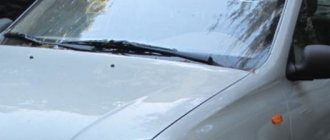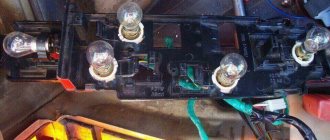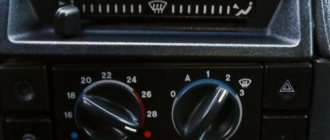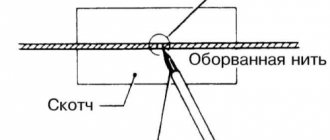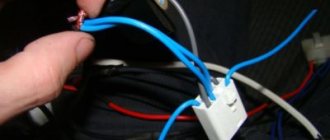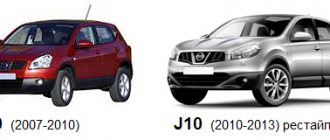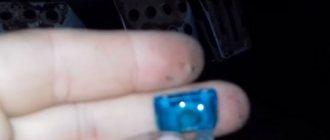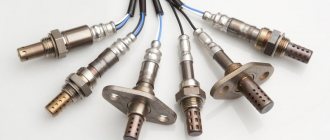Basic radio settings
The process of setting up the radio is not particularly difficult if you follow the general installation rules.
After installing the radio, you must connect the antenna. It comes in several types: adhesive, telescopic, external, internal. The main condition for it is the ability to work in AM and FM mode. Antenna connected but no signal? If the radio reception in the car is bad, what should I do? An external antenna is usually installed on the glass. This is where it is most susceptible to interference and damage. If everything is done correctly and there are no obstacles to the operation of the equipment, then you need to configure the device next.
Using the buttons on the panel or the radio control panel, radio channels are tuned for reception. The corresponding buttons change the frequency of the range and search for radio stations; if this frequency is known, you can add it manually. More modern models allow you to search automatically, while a radio wave with a good signal will remain in the device’s memory.
To remember your favorite channel, you can use numbering. If you want to save a particular radio station, just hold down the key with the selected number for a couple of seconds. Then, after pressing it, your favorite wave will turn on.
Reasons for a bad signal
There can be several reasons for a bad signal:
- Poor reception of radio stations due to distance from the transmitting signal or the presence of additional interference (railroads, power plant towers or mobile operators). Such interference eliminates itself after crossing the unstable reception zone. If a mobile phone or tablet computer is located near a radio receiver, during active operation there may also be interruptions in the purity of reception. People often ask why the radio reception in the VAZ-2114 car is poor, and what to do in this case. Experts advise moving the antenna to the roof of the car, thereby isolating interference using the housing.
- Antenna malfunction. You can fix the problem by replacing the antenna, soldering the bad contacts, and cleaning out the oxidation.
- Hissing or wheezing while listening to the radio may indicate a problem with the receiver. Most often the reason lies in a cracked board. If, after opening the device, the defect is confirmed, the board is soldered. However, this work requires maximum precision, so it is better to entrust it to a professional.
- If the radio reception in the car is poor when the recorder is turned on, then experienced motorists are advised to choose recorders with an autonomous battery. This is explained by the fact that interference is created when the DVR is connected to the cigarette lighter. Also, the problem of interference can be solved by replacing the device’s power supply with a better one, installing a stabilizer or ferrite rings on the power wire, which creates its shielding.
Checking the antenna
If a metal antenna is installed in the car, then one of the reasons for the poor signal may be its damage.
This situation is possible for the following reasons:
- after washing a vehicle, car wash workers sometimes damage the antenna or simply forget to push it back, which also interferes with receiving a radio signal;
- birds often deform the antenna in the parking lot;
- In winter, the device may become icy;
- hail can bend the antenna.
Drivers should remember that even minimal damage to the antenna leads to a deterioration in signal reception. Therefore, at the first sign, it is necessary to check the retractable element.
If the antenna has an electrical mechanism and is extended by pressing a button, then icing may interfere with the process and the radio signal will not be received with interference.
If the antenna is frozen during icing, then you cannot use force to return it to its normal state, especially using pliers.
1) Check the car antenna
If your car is equipped with an external metal antenna, there is always a risk of damage to it, which will lead to deterioration in the quality of radio reception. For example, an external retractable antenna can get damaged at a car wash (car wash workers often move the antenna to avoid damaging it and then simply forget to retract it again). It can also be damaged by a bird in the parking lot. Or the machine's antenna may be damaged due to ice formation in the winter. Especially during freezing rain, which can easily bend the antenna and even break it completely. Remember that even minor, unnoticeable damage to the external retractable antenna can significantly affect the quality of radio signal reception.
Therefore, at the first sign of a drop in the quality of radio reception of the radio, check the condition of the external car antenna.
It is quite possible that your antenna is simply not extended all the way and therefore radio channels are received with interference. In this case, you only need to extend the antenna according to the vehicle manual.
Checking the wire connections
One of the most common causes of interference is a poor connection between the car radio and the antenna connector. This is due to the fact that if there is poor contact between the antenna cable and the receiver, the transmission of the radio signal deteriorates. As a result, the speakers produce radio noise and interference. This mainly happens during body vibration or corrosion due to moisture.
Therefore, if the quality of signal transmission has deteriorated, after inspecting the antenna, it is necessary to check the cable at the junction with the receiver. When the radio reception in the car is poor, what should you do in this case? The radio installation is removed from the car or pulled out from the center console to inspect the device at the rear, where the cable connector is located.
If, after a visual inspection, no problems with the connector were identified, you should wait to install the receiver back; perhaps the antenna cable has hidden damage. It is necessary to turn on the radio on the wavelength that is causing interference and turn up the volume to hear the noise. Then move the cable at the connector. If the sound does not change, then the problem is not in the cable connection. On the contrary, if crackling, whistling and other extraneous sounds appear, then the problem is in the antenna cable or connector.
2) Check antenna connections
The most common cause of poor radio reception in a car is a poor connection between the car radio and the antenna connector. The fact is that if the antenna cable has a poor connection to the radio (with radio tuner), then the quality of radio transmission from the antenna to the receiver will be low. As a result, you will hear interference or only radio noise. Unfortunately, over time, body vibration causes many of the vehicle's wire connections to weaken and become susceptible to corrosion from moisture. This also applies to the connectors connecting the radio receiver to the antenna. As a result, the driver begins to experience difficulties in setting up high-quality radio channel reception.
So if you encounter poor-quality sound when listening to the radio in a car, then immediately after checking the antenna for damage, inspect the cable connecting the antenna to the radio. To do this, you need to remove the radio from the car or push it forward from the center console to inspect the rear of the tuner, where the antenna cable connector is located.
If during a visual inspection you do not find any problems with the connector, do not rush to install the radio back. Please note that the cable or connector may have hidden damage. Therefore, turn on any radio channel that has interference and turn up the volume to listen to extraneous noise. Then move the antenna cable (for example, you can move the radio antenna connector). If the connection is reliable and tight, then you should not hear any changes in the sound of the radio channel. If you hear noise, crackling, etc., then most likely either the antenna cable or the connection connector is damaged.
Checking the performance of the antenna
When the radio reception in a car is poor, not all drivers know what to do. If the antenna has been checked for external damage and there are no complaints about the wire connections, then it is worth making sure that the signal receiving device itself is working.
If dents, rust or similar damage is found on the antenna, the device must be replaced with a new one.
Modern cars are equipped with a mesh antenna that is glued to the rear or side windows. Such a device has an aesthetic advantage over an external antenna, but does not differ in the quality of radio signal reception. Also, the sticker can be damaged from the inside, for example by children. In this case, you will have to buy a new one.
3) Buy a new radio antenna for your car
When checking the connection between the antenna and the radio receiver, you may find that your antenna has signs of rust, dents or even breaks; in this case, without installing a new antenna, you will not be able to return the quality of signal reception to the previous level. Please note that rust can damage not only the antenna mast itself, but also its connectors at the junction with the cable that goes to the radio tuner in the car's head unit.
Also, many modern cars are now equipped with new types of radio antennas. This type of antenna is a mesh sticker that is glued to the rear or side windows of the car. These flat panel radio antennas have some aesthetic advantages over external metal car antenna masts. Firstly, the mesh antenna is glued inside the car and cannot be damaged at a car wash, by birds in the parking lot or from the formation of ice.
But unfortunately, such flat antennas do not receive the signal very well. Especially in big cities and hilly areas. Also, the main disadvantage of an antenna on glass is the need to purchase a new one if it is damaged on the inside. Moreover, it can be damaged very easily by simply touching the glass with something sharp.
How to choose a new antenna?
Many people are interested in, if the radio reception in the car is poor, which antenna to choose.
Devices are divided into two main types: active and passive. Let's take a closer look:
- Active antennas have a radio signal amplifier, which provides a high-quality signal in the city and beyond. Thanks to the internal installation of the antenna, it is protected from the influence of the external environment (precipitation, sun, temperature changes), therefore, its performance is higher. It is best to install the antenna in such a way that it does not interfere with the driver's view and does not come into contact with a metal surface. Most often it is mounted on the rear panel, windshield or in a window opening.
- A passive antenna is installed outside the car; it is a rod attached to the body of the car. It is secured using a magnet, by drilling a hole in the body, or by fixing it using the pin method. The efficiency of the antenna depends on the height of its location relative to the conducting surface. It is recommended to use an external antenna for people who travel most of the traffic outside the populated area. Because the sensitivity of passive antennas is higher than that of active ones.
Signal amplifier
Typically, if radio signal reception is poor, using an amplifier is ineffective. Especially if poor quality sound is caused by damage to the antenna, wear of the cable or connector. However, as a rule, this leads to deterioration of the radio signal of all channels.
However, there are times when new equipment is installed, and some channels continue to broadcast with interference. If the radio reception in the car is poor, what should you do about this problem? Each radio channel has a different transmitted signal strength and is therefore received differently by the radio device. In this case, the use of a signal amplifier is completely justified. It is important to clarify that the amplifier cannot cope with interference caused by high-rise buildings or due to the terrain.
Replacing a radio or amplifier
Basically, the radios that come with the car are quite high quality for listening to music and receiving radio broadcasts. But not all devices have similar qualities. Often, expensive equipment equipped with CD and DVD media with incredible sound quality has a poor radio tuner. And the equipment installed in premium cars is not always characterized by a high quality radio.
For example, drivers often face the problem that the radio in a Toyota car has poor reception. What to do in this case? Experts explain that some radios are not designed for the frequency range of our radio stations. To get rid of the problem, it is recommended to buy a new suitable radio or amplifier suitable for our country. In this case, it is necessary to remove the standard amplifier from the foreign car.
Replacing the radio
If, after numerous checks of the functionality of all connections and the antenna, the signal remains weak, then most likely you will have to change the radio. But how to understand the huge variety of all kinds of devices for playing radio.
There is an opinion that any Chinese radio receiver does not pick up the radio well. This is actually a misconception. There are models in different price categories on the electronics market. In addition, competition in such markets is too high and it is not profitable for manufacturers to produce low-quality goods.
Radio Pioneer
Pioneer radios have proven themselves well in terms of the quality of reception and processing of radio signals in the car. And yet, when buying a new radio, pay attention not only to the manufacturer, but also to the price component.
So we have looked at the main points related to poor-quality radio signal reception. Always check the condition of your external radio before traveling. And before you sin on your favorite radio station, remember the above, maybe the problem is not in your radio at all, maybe it lies on the surface, and in the everyday bustle we simply stopped noticing it.
I wasted my time reading this information, which is of no use. It’s not clear why it was written at all? Change the radio if the radio reception is bad... and if the new radio is also bad reception, then buy a third one?
Briefly about the expert: he graduated from physics and mathematics school, graduated from LETI University with a degree in Radio Receiving Devices, and completed graduate school. Has been involved in radio communications since 1984.
This is the first part. The second part about powering an active antenna is HERE!
Antennas are supposed to receive radio waves and transmit them to the radio, but sometimes something goes wrong and your radio produces a terrible wheeze instead of the clear sounds of a song, but when playing a CD everything is fine.
“It’s the antenna’s fault,” you decide. Sometimes this is true, the antenna is at fault, and sometimes it is not. Sometimes the radio is to blame. And sometimes neither the antenna nor the radio is to blame. What then? Read below!
1. Situation one . Taken from here. Further, as the Author writes: “The other day I replaced the 2-din media center with a new one; the old one fell apart in 7 years, although the radio worked perfectly. So here it is. I plugged the standard cable into the antenna connector, but the radio reception was simply disgusting. It feels like there is no antenna. The signal floats specifically. Maybe I damaged something when I changed it?”
Another car owner gives him the answer. Taken from here. “I encountered a problem that I couldn’t pick up the radio well, at first I blamed the antenna, so I decided to take it apart to see what was there and how it was. I took it off and took it apart, but everything inside turned out to be very decent, nothing was broken anywhere, nothing was rusty, I began to think that micro cracks had formed in the board, and the whole thing needed to be soldered. I went to a TV studio, where I heard the answer that everything was fine, there was no need to solder anything. I went home and started scouring the Internet in search of an answer to my problem, everyone wrote only one thing: solder, solder, and that’s it. And then I completely accidentally came across one forum, where I found out that there is an amplifier in the antenna that is powered by the standard radio through the connector where the antenna is inserted, and when replacing this radio, as for example in my case with a pioneer, the amplifier stops working as on regular ones. On radios, no current passes through the connector where the antenna is inserted. It turns out we just need to re-power the amplifier and everything should work.”
